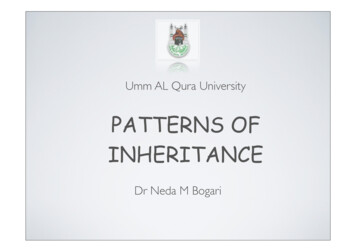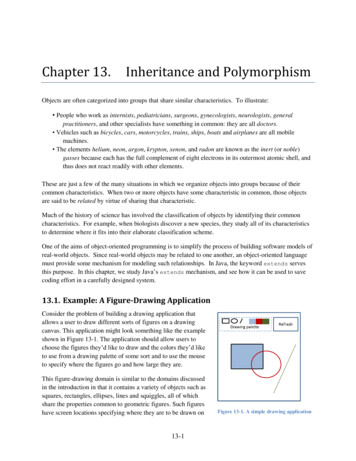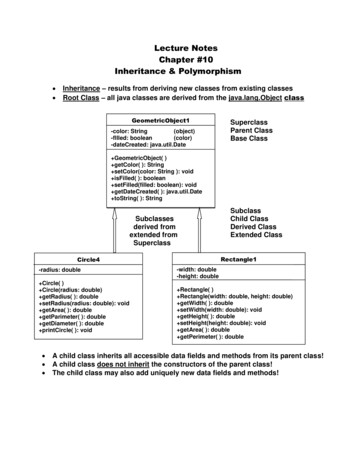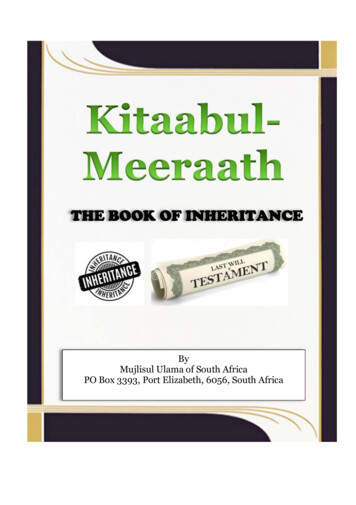
Transcription
Chapter 14: Patterns of Inheritance INTRODUCTION TO GENETICS APPLIED GENETICS.
Chapter 14A: INTRODUCTION TOGENETICS Mendel Rules and Terminology for Examination of GeneticInheritance Expanding the Rules and Terminology to follow two(or more) genes in a cross Beyond simple genetics: Mendel picked easy fights Sex determination and sex chromosomes.
Compare and describe the relationshipbetween:– P generation (or P1) / F1 generation / F2generation– phenotype / genotype– gene / locus / alleles– dominant allele or trait / recessive allele ortrait– homozygous / heterozygous / hybrid.
The foundation of genetics: Mendel’slaws of inheritancethe basic rules ofinheritance were firstdemonstrated by GregorMendel in the mid-1800s at the time of Mendel’swork, most thoughtthat parental traits werefluids that “blend” inoffspring Mendel recognized thatthis model did notexplain what heobserved.
The foundation of genetics: Mendel’slaws of inheritanceMendel chose a modelsystem and carefullyestablished testingconditions he used pea plants thathe could outcross orallow to self-fertilize he chose traits that hadtwo clear possibleoutcomes (yellow orgreen seeds, etc.) he established truebreeding or “pure” linesto use for geneticcrosses.
terminology for genetic crosses P generation (or P1) parental generation F1 generation first generation offspring (from filial) F2 generation second generation offspring phenotype – appearance or characteristic of anorganism genotype – genetic makeup of an organism,determines phenotype gene – unit of heredity; controls a trait thatdetermines a phenotype locus – the location of a particular gene on achromosome alleles – alternative versions of a gene dominant – allele that dominates over others indetermining phenotype recessive – allele whose phenotypic expression is“hidden” when a dominant allele is present hybrid – offspring from a cross between two “pure”lines of different, competing phenotypes.
Chapter 14A: INTRODUCTION TOGENETICS Mendel Rules and Terminology for Examination of GeneticInheritance Expanding the Rules and Terminology to follow two(or more) genes in a cross Beyond simple genetics: Mendel picked easy fights Sex determination and sex chromosomes (Ch. 15.3).
Mendel’s Law of Segregation when Mendel crossedpure lines of different,competing phenotypes F1 generation wasuniform and matchedone of the parents’phenotypes example: P1 yellow seedX green seed all F1yellow seed.
Mendel’s Law of Segregationwhen F1 plants were crossedor selfed, the F2 plants hadboth P1 phenotypes in aratio of roughly 3:1 using offspring from aboveF1 X F1 F23 yellow seed: 1 green seedSo recessive traits are notlost in a mixing of parentalphenotypes – they aremerely hidden in some“carrier” individuals.
.
Mendel’s Law of SegregationMendel explained these ratios withwhat we now call his law ofsegregation; stated in modern terms: individuals normally carry two allelesfor each gene; these alleles mustsegregate in production of sex cellslater investigations of cell divisionrevealed the mechanism forsegregation: the pairing andsubsequent separation of homologouschromosomes during meiosis.
Genotype vs. Phenotypephenotype is the actual appearance orcharacteristic, and is determined by genotype knowing the phenotype will not always directlyreveal the genotype (recessive traits can bemasked)genotype is the listing of the actual allelespresent; if you know the genotype, you shouldbe able to predict the phenotype.
Genotype vs. Phenotypegenotypes are either homozygous or heterozygous homozygous – the homologous chromosomes have the sameallele at the locus in question; the trait from that allele will beexpressed heterozygous – the homologous chromosomes have differentalleles at the locus; if there is a dominant allele the trait of thedominant allele will be expressed the same letter is used to indicate all alleles (superscripts orsubscripts are sometimes needed, if there are more than 2alleles known) DOMINANT ALLELES ARE CAPITALIZED; recessive allelesare lowercase.
Compare and describe the relationshipbetween:– P generation (or P1) / F1 generation / F2generation– phenotype / genotype– gene / locus / alleles– dominant allele or trait / recessive allele ortrait– homozygous / heterozygous / hybrid.
Draw a Punnett square and list thepredicted fractions for each genotypeand phenotype for this cross:heterozygous (yellow seeds) Xheterozygous (yellow seeds) where yellow seeds is dominant overgreen seeds.
Applying the Law of Segregation: Probabilityrules of probability govern genetic inheritance the likelihood of a sex cell carrying a particularallele is determined by probability, its expectedfrequency of occurrence expressed in fractions, decimal fractions, percentages, orratios – any of these is fine to use the combination of sex cells to form a zygote isgenerally ruled by probability as well thus, the rules of probability govern genetics.
Applying the Law of Segregation: Probability product rule – when independent but notmutually exclusive events are combined, youmultiply their individual probabilities to get theoverall probability of the result sum rule – if there is more than one way toobtain a result (mutually exclusive events), youadd their individual probabilities to get theoverall probability of the result the sum of all possibilities is one (no more, noless).
Applying the Law of Segregation: Probability Punnett square – way of diagramminggenetic crosses that uses the laws ofprobability.
Applying the Law of Segregation: Probability Punnett square –way of diagramminggenetic crosses thatuses the laws ofprobability.
Draw a Punnett square and list thepredicted fractions for each genotypeand phenotype for this cross:heterozygous (yellow seeds) Xheterozygous (yellow seeds) where yellow seeds is dominant overgreen seeds.
practice applying the law of segregation:following one gene in a cross
Applying the Law of Segregationmore terminology test cross – mating anindividual that has thedominant phenotype for atrait with an individualwith the recessivephenotype this often will reveal thegenotype of the dominantparent, or at least givesome idea of the probablegenotype.
Applying the Law of Segregationmore terminology monohybrid cross –cross betweenindividuals that areboth heterozygousfor the gene that youare following.
Applying the Law of Segregationa monohybrid crossresults in a3:1 phenotype ratioand1:2:1 genotype ratio.
practice applying the law of segregation:following one gene in a cross A pea plant with yellow seeds is crossed witha pea plant with green seeds (P1 generation).All 131 offspring (F1 generation) have yellowseeds. What are the likely genotypes of theP1 plants?
practice applying the law of segregation:following one gene in a cross Two of the F1 plants from before arecrossed. What are the expected ratios ofphenotypes and genotypes in the F2generation?
Study Tip be sure to work some examples onyour own; the textbook and websitehave plenty of genetics problems –note how they are typically presentedas word problems and expect thatformat on your test.
Chapter 14A: INTRODUCTION TOGENETICS Mendel Rules and Terminology for Examination of GeneticInheritance Expanding the Rules and Terminology to follow two(or more) genes in a cross Beyond simple genetics: Mendel picked easy fights Sex determination and sex chromosomes (Ch. 15.3).
[make up about 3 practice two-gene crosses].
Mendel’s Law of Independent Assortment dihybrid cross – crossbetween individuals thatare both heterozygous fortwo different genes thatyou are following when Mendel performeddihybrid crosses he foundphenotype ratios of9:3:3:1 note that this follows theproduct rule:3:1 x 3:1 9:3:3:1.
Mendel’s Law of Independent Assortmentthis led to his law of independentassortment: segregation of any one pair of allelesis independent of the segregation ofother pairs of alleleswe now know that this is also aconsequence of events in meiosis.
Mendel’s Law of Independent Assortment this is also a consequence of events in meiosis –the independent assortment of homologouschromosomes during Meiosis I.
METAPHASE IMETAPHASE IIbsBSbSBs
.
Mendel’s Law of Independent Assortment law of independent assortmentdoesn’t hold perfectly true for allgenes (more on genetic linkagethat violates this law later).
Mendel’s Law of Independent Assortmentusing the law ofindependent assortmentin genetic problems with independentassortment a dihybrid crossis simply two separatemonohybrid crossesmultiplied avoid making tedious anddifficult Punnett squares like we will work examples inclass; be sure to try some onyour ownThe hard way No no no!!!.
Mendel’s Law of Independent AssortmentAn easier way to do RrGg x RrGg(note for alleles: R round, r wrinkled; G yellow, g green)RGrgR RR RrGGG GgrgGg ggRrrr3 round1 wrinkledX3 yellow1 green 9 round, yellow3 round, green3 wrinkled, yellow1 wrinkled, green
[make up about 3 practice two-gene crosses].
Mendel’s Law of Independent Assortment independent segregation ofchromosomes during meiosis I leads toindependent assortment independent assortment can lead torecombination .
Determine predicted results for the testcross used in the genetic linkageexample.
Mendel’s Law of Independent Assortment recombination – any process that leadsto combinations of genotypes not seenin the parents recombinant gametes – gametes thatdisplay a recombinant genotype recombinant offspring – offspringwhose phenotype reveals that theyinherited genes from a recombinantgamete.
Genetic linkage – independent assortmentdoes not always occur genes that are on the same chromosome maynot sort independently; such genes are saidto be linked.
Genetic linkage – independent assortmentdoes not always occurcrossing over breakslinkages between genes recall crossing over duringprophase I betweenhomologous chromosomes; itis the only way to get geneticrecombination between genesthat are on the samechromosome the further apart two genes are,the more likely they are to havecrossing over occur betweenthem (thus leading to geneticrecombination).
Genetic linkage.
.
Determine predicted results for the testcross used in the genetic linkageexample.
Genetic Maps of Chromosomespercentage of crossing over or recombination is calculated from 100map unit – by convention, one map unit 1% recombination x number of recombinant offspringthe total number of offspringthe term cM or centiMorgan is sometimes used for map units, inhonor of Thomas Hunt Morgan, the pioneer in gene mappingmap distances between genes on the same chromosome aremeasured in map units.
Genetic Maps of Chromosomes linkage group all genes on a particularchromosome; tend to be inherited together.
Genetic Maps of Chromosomes placement of a gene into a position in alinkage group is genetic mapping.
Discuss how you could map gene C.
Genetic Maps of Chromosomesmap distances get lessmeaningful as they get large as genes get further apart, theodds of multiple crossing overevents between them increase when distances approach 50map units, the genes appearessentially unlinked many chromosomes have anoverall map length of well over50 map unitsgenetic maps are useful inlocating the actual physicallocation of genes.
Genetic Maps of Chromosomes.
Methods of studying human inheritance:family pedigree analysis pedigree – a chart summarizing phenotypes and/or genotypes withina family over several generations pedigree analyses only work well when a single locus is involved indetermining a phenotype (so-called Mendelian traits).
Methods of studying human inheritance:family pedigree analysis pedigree – a chart summarizingphenotypes and/or genotypes within afamily over several generations pedigree analyses only work well when asingle locus is involved in determining aphenotype (so-called Mendelian traits).
A PedigreeAnalysis ofAlbinism Successivegenerations marked byRoman numerals Individuals in eachgeneration are markedby Arabic numerals Is albinism dominant? Is it sex-linked?.
.
PedigreeAnalysis Isthe filled-intrait dominantor recessive? Isit sex-linkedor not?.
PedigreeAnalysis Isthe filled-intrait dominantor recessive? Isit sex-linkedor not?.
PedigreeAnalysis Isthe filled-intrait dominantor recessive? Isit sex-linkedor not?.
Describe three different ways in whichsex is determined. Describe the homogametic andheterogametic sexes for humans andthen for birds.
Sex Determination and Sex Chromosomes see Ch. 15.2 for textbook coverage of this issue sex determination varies between species hermaphroditic organisms – have both sexes in thesame individual many animals have sex determined in response toenvironmental signals most animals have sex determined by geneticinheritance; sex chromosomes are involved.
Sex Determination and Sex Chromosomessex chromosomes homogametic sex – has a pair of similar sex chromosomes;all gametes that individual produces get that kind of sexchromosome heterogametic sex – has two different sex chromosomes, andmakes gametes with two different types of sex chromosome the sex chromosome inherited from the heterogametic sexgenerally determines the sex of the offspringall the other, non-sex chromosomes are calledautosomes.
Sex Determination and Sex Chromosomes usually, the sex chromosomefound in the homogameticsex is considerably larger,and the shorter sexchromosome found only inthe heterogametic sex hasfew genes in humans, females are XXand males are XY (not all do itthis way – birds areessentially reversed in this) X and Y chromosomes haveregions of homology(sequence similarity) thatallow for pairing duringmeiosis I.
Describe three different ways in whichsex is determined. Describe the homogametic andheterogametic sexes for huma
rules of probability govern genetic inheritance the likelihood of a sex cell carrying a particular allele is determined by probability, its expected frequency of occurrence expressed in fractions, decimal fractions, percentages, or ratios –any of these is fine to use the combination of sex cells to form a zygote is generally ruled by probability as well thus, the rules of probability govern .











